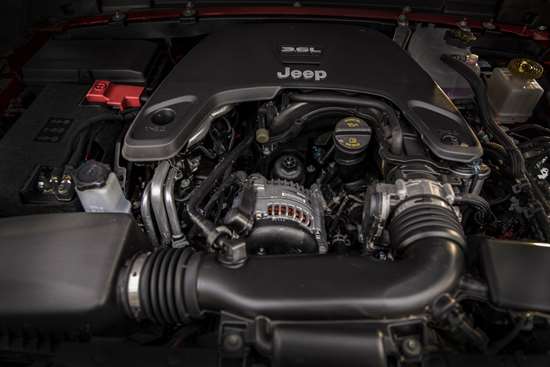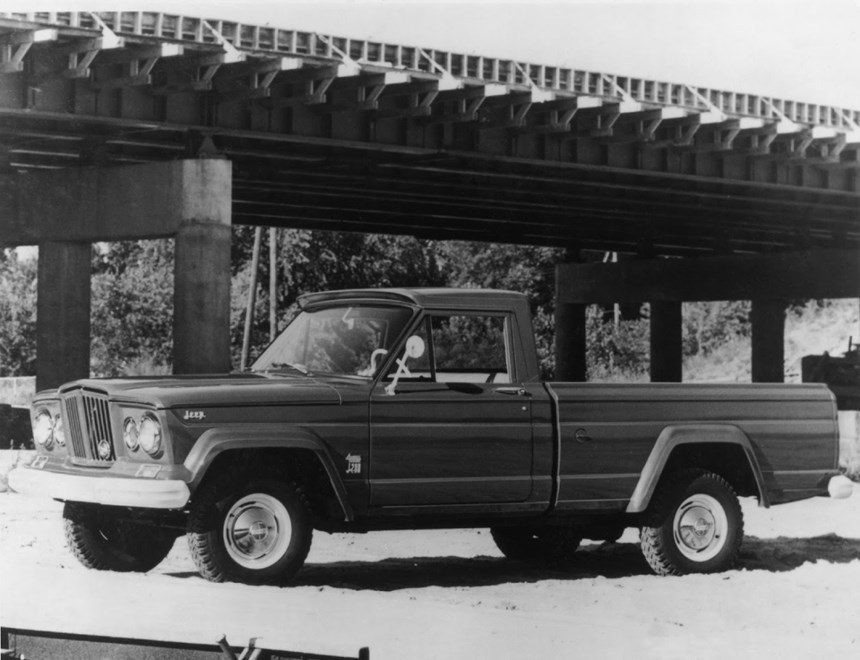What to Know About the 2020 Jeep Gladiator
It is a Jeep. It is a truck. It is designed and engineered so that both characteristics are there without compromise.
#aluminum #interior
When you first look at the 2020 Jeep Gladiator, it is difficult to imagine that the first thing that you think isn’t “That looks like the new Wrangler with a box on the back.” The resemblance is certainly there, from a design point of view. At least from a macro level. But when we talk to the people responsible for designing and engineering the new vehicle, we learn what is really is, which is a Jeep that’s a midsize pickup truck.
What’s in front?
Mark Allen says that the grille of the Gladiator is very much like the keystone grille on the Wrangler JL in appearance, but it’s not the same grille. Rather, the spacing between the slots is wider on the Gladiator’s grille in order to provide more air to the engine box because this is a pickup truck as well as a Jeep, and part and parcel of being a midsize pickup truck—in addition to having a five-foot box on the back—is the ability to tow. And depending on the model, the Gladiator can tow loads anywhere from 4,000 lb. to 7,650 lb. (which we’ll get to, below).
What’s in a name?
Allen says that there was “a lot of spirited discussion about what to call the vehicle.”
In many ways Jeep is all about heritage. And when it comes to that, its history in producing trucks is quite extensive.
There was the Willys-Overland truck from 1947 to 1965. Then the Jeep FC-150 and FC-170 from ’57 to ’65, which, round headlights and slotted grille notwithstanding, have a cab-over-engine design and look nothing like what one might imagine a “Jeep” looks like.
The ‘60s are when the Jeep trucks came into their own, with the first Gladiator J-series truck in ’63 (to ’87); the Jeep J-2000 and J-3000 pickups (SJ) in ’65 (to ’71). The Gladiator J-4000 from ’69 to ’74. And the Jeep M-715 from ’67 to ’69.
In the early 1970s the J-10 and J-20 pickups arrived (and were in production until ’87). The Jeep Comanche (MJ) ran from ’86 to ’92.
Given that Jeeps have names not alphanumerics, it pretty much came down to the Gladiator and the Comanche. (Overland is used as a trim level.) The Gladiator got the nod, in part, because, Allen says, the Comanche was a small truck and the new Gladiator competes in the midsize segment. Although arguably compared to even the full-size pickups circa 1986, the 2020 Gladiator would be gladiator-like in its dimensions: 218 inches long; 73.8 inches wide; 75 inches high (a Rubicon with a soft top); and a 137.3-inch wheelbase; the box, incidentally, handles 35.5-cubic feet.
And while on the subject of dimensions and going back to the substantial familial resemblance to the Wrangler (chief engineer Pete Milosavlevski: “You can’t just take a Wrangler and put a box on it; it doesn’t work that way.”), the Gladiator’s frame is 31 inches longer than that of the Wrangler and the wheelbase is 19.4 inches longer.)
What’s it made out of?
The term “mixed materials” is often cited nowadays in discussions of vehicle engineering. The Gladiator is almost a poster child for that term.
The cab structure is steel. The box is steel. The frame is high-strength steel. And there are four steel cross-members used to reinforce the load floor of the bed (maximum load capacity: 1,600 pounds). The Rubicon’s rear bumper is steel (other versions have composite bumpers) as are its rock rails. There are full-width forged steel track bars, and the rear five-link coil suspension features forged steel control arms (two upper and two lower).
Then there’s aluminum. This material is primarily used for closures: doors, door hinges, hood, fender flares, windshield frame, and tailgate. Although the use of aluminum is cited as a means of reducing mass to help improve fuel economy, it is worth noting that the doors are removable and the windshield folds forward onto the hood (a clever design touch is that the Torx bit size necessary for door removal is stamped on the hinges and the Torx toolkit is standard equipment), so lightweight makes it a whole lot easier on the person who is going to do those things. (Allen points out that the reason the windshield folds goes back to the original World War II models: the folding windshields facilitated crating of the vehicles for shipment overseas. He notes, “It is a fun, unique feature on the Wrangler, so why not have it on the Gladiator?” Allen asks and answers: “Why would you put the windshield down? Because things that don’t have windshields are fun modes of transportation—bicycles, horses, roller coasters.”)
Comparatively speaking, the amount of composites is less than that of steel and aluminum, but nonetheless an important part are made with the material: the hardtops. Which, of course, are removable.
(There is also a fabric soft top available that is not only removable, but which allows partial opening for a convertible-like arrangement.
What’s clever inside?
The rear seat and storage setups are is more reminiscent of something their colleagues have done with the Ram 1500 (although it should be noted that Pete Milosavlevski and Elizabeth Krear, who is charged with orchestrating all of the engineering for the vehicle, both had key roles in Ram 1500 development prior to going to the Gladiator program, so perhaps this isn’t entirely surprising).
Yes, the 60/40 split rear seat can fold flat. And a nice touch is that there are LED lights on the quarter trim panels to provide illumination for the storage space that is behind the seats.
Then there is the ability to fold the seats up (a.k.a., “stadium position”), which then reveals a standard open storage bin, which allows the use of that space to store whatever.
But there is an available locking storage bin that features two different-sized doors: each door is coordinated with the 60/40 split. This is a lockable storage compartment.
“We know how people use these vehicles,” Chris Benjamin, head of Jeep Interior Design, says, which gets to the point of that lockable under-seat storage bin. When you’ve taken the doors and roof off of your vehicle, it is fairly wide open, so if you want to provide at least some storage security, then there’s that bin.
And in the event that there is a need to take that bin out of the vehicle, it is bolted in place, the bolts for it—as well as for the bolts for the doors, windshield and top—have a tool bin with graphics showing what goes where (instead of simply ending up with a box of bolts).
The lock is the same as that used for the glove box and the storage unit on the center console, so the Gladiator owner doesn’t need to have some sort of keychain to accommodate various locks.
One of Elizabeth Krear’s favorite options for the vehicle is a removable Bluetooth speaker. The speaker has a docking station that keeps it charged. But it can be removed from the vehicle and used in one’s campsite or wherever. Krear points out that unlike the Bluetooth speakers that one can purchase from a big-box store, this is “tested to automotive standards.” It has, she says, “the highest rating for dust and moisture,” and it can get really moist, as it can be dropped in water and work after retrieval (which has to occur in minutes).
What’s the max towing capacity?
One of the things in the midsize pickup truck segment that seems to be no less important than in the full-size category (albeit with somewhat reduced metrics) is the towing capability. So needless to say, out of the gate the Gladiator is, in the words of chief engineer Pete Milosavlevski “best-in-class” when it comes to towing, with the ability to haul 7,650 pounds. (This best-in-class is for a midsize with a gasoline engine, not a diesel, because the 2019 Chevrolet Colorado 2WD with a Duramax 2.8-liter four-cylinder turbodiesel is rated at 7,700 pounds.)
And even though there is that separated-at-birth resemblance between the JL Wrangler and the Gladiator, know that the maximum towing capacity of the JL is 3,500 pounds. Which meant that Milosavleski and his team had their work cut out for them capacitizing the Gladiator for more than doubling that capacity. It should be noted that the standard engine for the Wrangler and the only currently available engine for the Gladiator (a 3.0-liter turbodiesel will be coming next year) are the same 3.6-liter Pentastar V6. In the case of both vehicles, the horsepower rating is the same: 285 hp @ 6,400 rpm; the torque is essentially the same, as well, at 260 lb-ft, although in the case of the Gladiator that is achieved at 4,400 rpm and it is 4,800 rpm for the Wrangler. And as for the transmissions, both are available with a D478 six-speed manual or an 850RE eight-speed automatic. All that said, it must be pointed out that this isn’t 7,650 pounds across the board for the Gladiator. There is one version (there are four trim configurations: Sport, Sport S, Overland, and Rubicon) that achieves it: A Sport with the optional eight-speed and Max Trailer Tow package. The vehicle is equipped with an electronic fan under the hood, 32-inch tires and a 4.10:1 axle ratio. Then you can tow a lot.
The other versions of the Gladiator can tow, too, but just not as much. It ranges from 4,000 pounds for Sport and Overland models with the manual transmission to 7,000 for a Rubicon with an automatic.
What makes the Gladiator different?
One of the mantras repeated by Team Gladiator members is “100 percent truck; 100 percent Jeep.” Every Gladiator is 4WD. There are third-generation Dana 44 heavy-duty axles on the front and rear. There’s Tru-Lock electric front- and rear-axle lockers and a Trac-Lok limited slip differential. The Sport and Overland models come standard with a Command-Trac transfer case; the Rubicon has a standard Rock-Trac transfer case. The Sport and Overland have gas-charged monotube shocks front and rear; the Rubicon is equipped with high-pressure, gas-charged Fox shocks.
The Sport and Overland have an approach angle of 40.8°, a breakover angle of 18.4°, a departure angle of 25°, and ground clearance of 10 inches. The numbers for the Rubicon are 43.4°, 20.3°, 26°, and 11.1 inches.
The point is: yes, there are other midsize trucks out there. Some of them can be equipped to do things off-road. But this is a midsize truck that is essentially based on the ability to climb rocks and slog through mud. And carry stuff in the back, too.
That’s what the 2020 Jeep Gladiator is about.
RELATED CONTENT
-
Increasing Use of Structural Adhesives in Automotive
Can you glue a car together? Frank Billotto of DuPont Transportation & Industrial discusses the major role structural adhesives can play in vehicle assembly.
-
Aluminum Sheet for EV Battery Enclosure
As the number of electric vehicles (EVs) is about to increase almost exponentially, aluminum supplier Novelis is preparing to provide customers with protective solutions
-
Creating a Low-Cost Chassis Architecture
The engineers at Zenos Cars have combined recycled carbon fiber, drinking straws and aluminum to create a chassis for a low-volume sports car.


.jpg;width=70;height=70;mode=crop)




